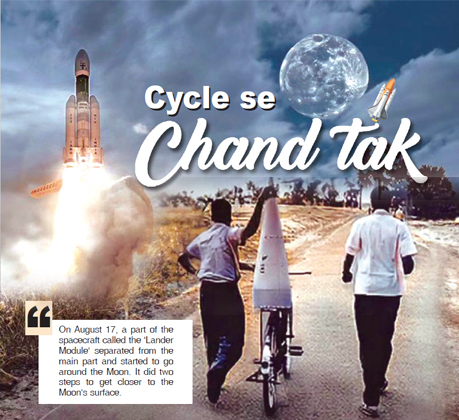The Indian Space Research Organization (ISRO) sent Chandrayaan-3 into space on July 14. This was to achieve a goal that was not met about four years ago. The big rocket named LVM3-M4 took off from Sriharikota in Andhra Pradesh. It went into
space. The rocket’s path was changed a few times over 18 days to move it towards the Moon. It finally reached the Moon on August 5.
On August 17, a part of the spacecraft called the ‘Lander Module’ separated from the main part and started to go around the Moon. It did two steps to get closer to the Moon’s surface
Then, on Wednesday on August 23 at around 5:44 pm, the lander part reached the place where it was supposed to land. ISRO sent a command to it to start landing. The lander used its artificial intelligence to carefully land on the Moon’s
surface. After coming down from high up, it adjusted its path using cameras and other instruments. It finally found a good spot and landed successfully on the Moon. This is a special achievement because it’s the first time anyone has landed
safely at the Moon’s South Pole. Even countries like the USA, Russia, and China, which are very strong in space, haven’t done this. India has made a new and important record by achieving this tough feat.
What is next?
Even though no one has explored the southern parts of the Moon yet, Chandrayaan-3 is ready to explore there. The Vikram lander and the six tools on the Pragyan rover are the same as the ones used in the last Chandrayaan-2 mission. The
lander with payloads will provide data to the scientific community about the lunar atmosphere, its surface gases and accurate distance between Moon and Earth. The rover has two tools. They are made to learn about what the Moon’s surface is
made of, like its chemicals and minerals, and also what elements are in the Moon’s soil and rocks, such as magnesium, aluminium, and iron.
A Journey of the ISRO
From the time when scientists used to carry rocket equipment on their bicycles, to now world looking up to INDIA, the journey of ISRO has been amazing. ISRO was officially created in 1969 with Vikram Sarabhai leading it. It began doing
experiments from other countries’ launch sites as it didn’t have its own place to launch rockets. But over time, it learned how to launch rockets on its own, which is inspiring to many.
People criticized the idea of exploring space in India in the 1960s. They thought it was a waste of time and resources. However, ISRO proved them wrong through its experiments. They started by launching rockets from a place called Tumba
Equatorial Rocket Launching Station in Thiruvananthapuram. These rockets could only reach the upper part of the air. With the hard work of scientists, India made its own satellite called Aryabhatta. But because there was no rocket and
launchpad, it had to ask the Soviet Union for help to launch it in 1975. In 1979, India did a series of tests called Rohini. After that, it built its own launch pad and developed a rocket called PSLV through many trials.
ISRO launched the PSLV rocket that they designed for the first time on September 20, 1993. Unfortunately, it didn’t work properly and crashed. But after making some changes, ISRO succeeded in launching the PSLV rocket on October 15, 1994.
This time, it worked and India felt proud. The PSLV rocket successfully launched the IRS- 1D satellite on September 29, 1997, and since then, India has been making progress in space exploration without stopping. The recent Chandrayan-3 is
another landmark.
Ref for the Pic:
https://twitter.com/APillania/status/
1694327667892555838?s=20

















Add Comment